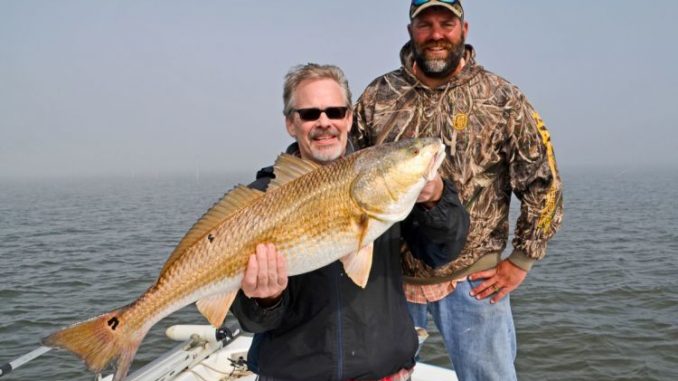
What gives Lloyd Landry IV and Tenney Flynn the authority to discuss the qualities of Sciaenops ocellatus, the red drum — what we call “redfish?”
Both men have credentials: One is an expert at catching fish, while the other is an expert at cooking fish.
The 43-year-old Landry has been a self-employed charter fishing and duck hunting guide for 15 years. Before that, he split his time between being a part-time guide for Ryan Lambert, owner of Cajun Fishing Adventures, and working at a chemical plant near his home in Luling.
“I got to where I was fishing more than working at the plant,” he said, grinning through his dense, furry beard. “I hated working at the plant. My wife Beth suggested that I quit. My dad worked at a plant for 35 years and never came home happy. In two years, that happened to me.
“Beth knew where I was going when I got up in the morning. If I was grumpy, I was going to the plant; If I was whistling and happy, I was going fishing.”
So he quit the plant job and started Outcast Fishing Charters, specializing in chasing speckled trout and redfish from Empire (where he has a lodge for customers) to Venice.
“Inland fishing is what I do,” he said.
The 61-year-old Flynn grew up steeped in the restaurant business in Stone Mountain, Ga.
“My earliest memories are of being in my father’s restaurant — the smell of dry aging beef, the smell of lobsters,” Flynn said. “I worked in the back (where the food is cooked and the dishes are washed) until I was 15, and then moved to the dining room so I could get tips.
“I was sort of a bad child, by any definition delinquent. But I didn’t get caught too often.”
After high school, Flynn spent about eight years in the bar business, including managing a rock-and-roll club.
“During that time, I quit drinking and drugs, and I found out I didn’t enjoy that environment sober,” Flynn said.
He looked around for direction, and ended up applying to and attending the Culinary Institute of America in Hyde Park, New York.
“I really enjoyed that,” Flynn said. “I did my externship at the Atlanta Fish Market.”
The following seven years, he worked his way up from line cook to executive chef, and then moved to the Ruth’s Chris Steakhouse chain as corporate chef in 1992.
After they parted ways, he discussed a high-end fish restaurant concept with Gary Wollerman, his former boss at Ruth’s Chris.
Both men lived in New Orleans, so its location there was a natural.
“There was resistance from others,” Flynn said with a chuckle. “‘How dare you two, one from Kansas City and one from Atlanta, come here and show us how to cook fish when we already have two ways — fried and broiled?’
“We opened in March 2001. At Ruth’s Chris, 10 percent of our sales were seafood. In GW Fins, 10 percent of our items are non-fish for those poor souls who say they don’t like seafood.”
Flynn’s focus is obtaining the freshest seafood possible.
“Seventy percent of our seafood comes from the Gulf,” he said. “My conversation with (suppliers) is always asking for what is freshest, not ‘do you have any of this species or that species.’ We print our menu every day, meaning we get diversity. We have 10 finfish on the menu.
“We know what we get. We buy whole fish and have a fish-cutting table with a refrigerated cutting surface. Employees are trained to cut each particular fish. The fillets go into ice in a metal pan and (are) then stored in plastic bags in bowls of ice in a refrigerator.
As if his kitchen credentials aren’t enough, Flynn is a voting member of the Louisiana Seafood Promotion and Marketing Board representing the restaurant industry.
